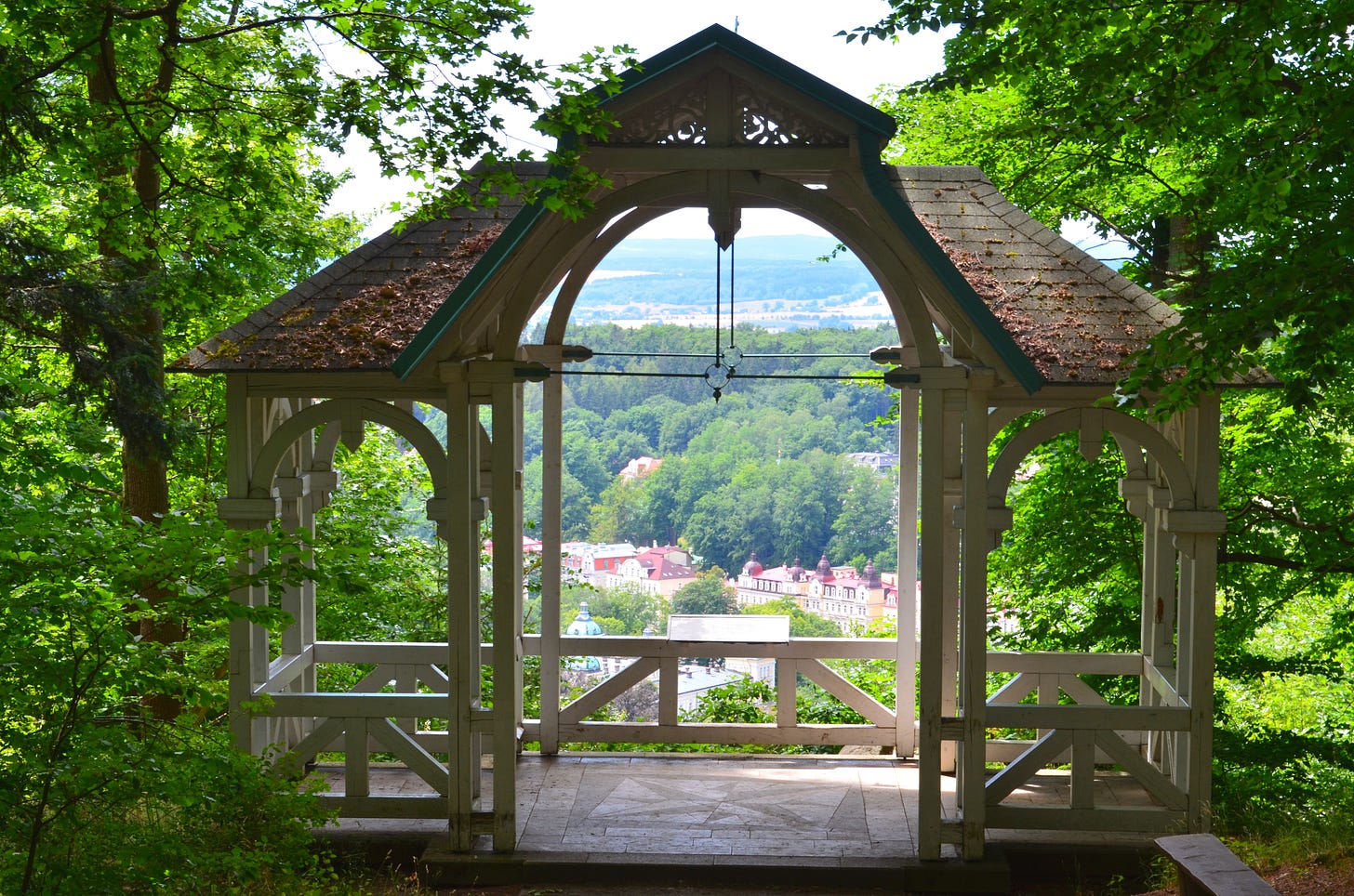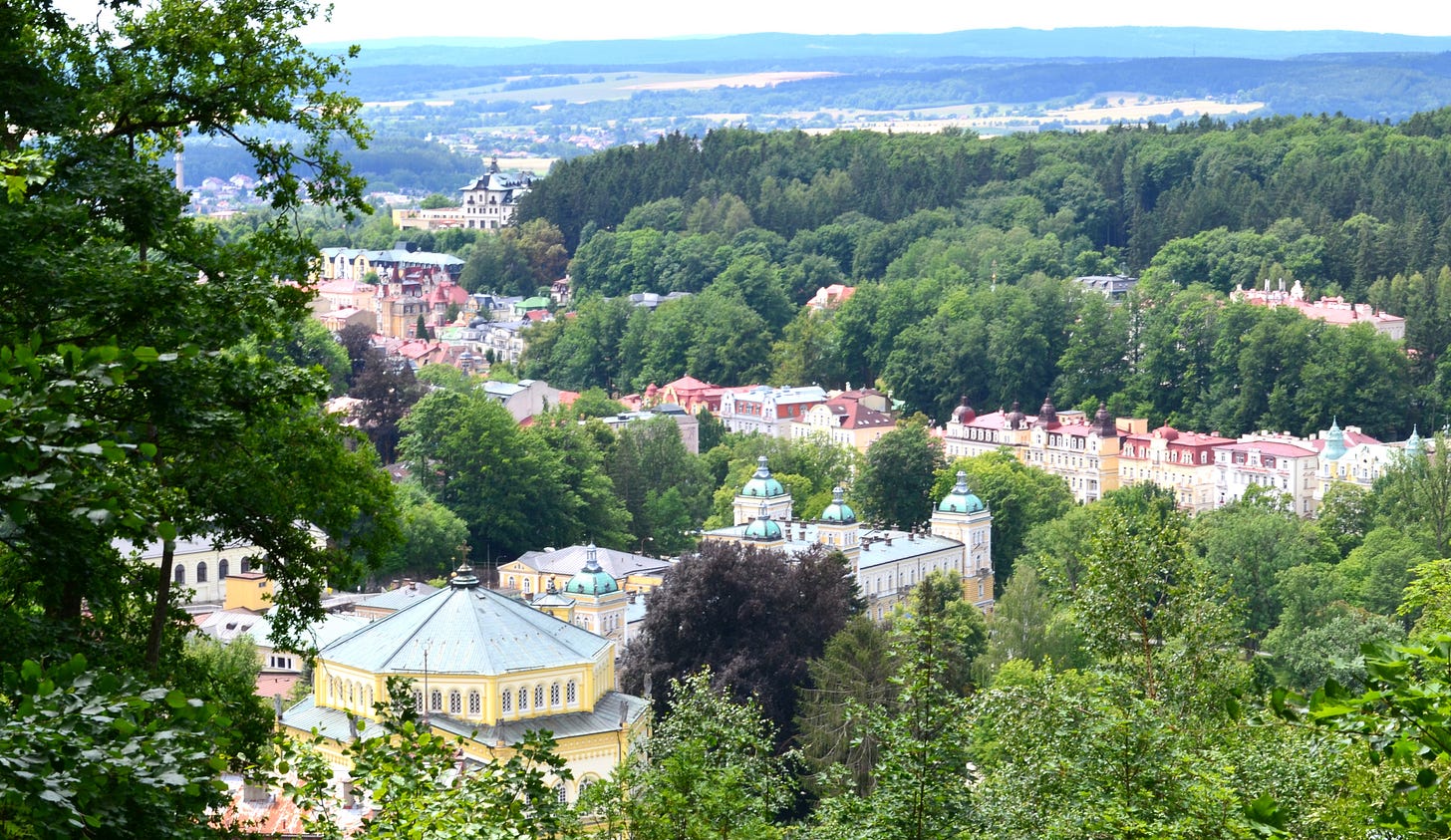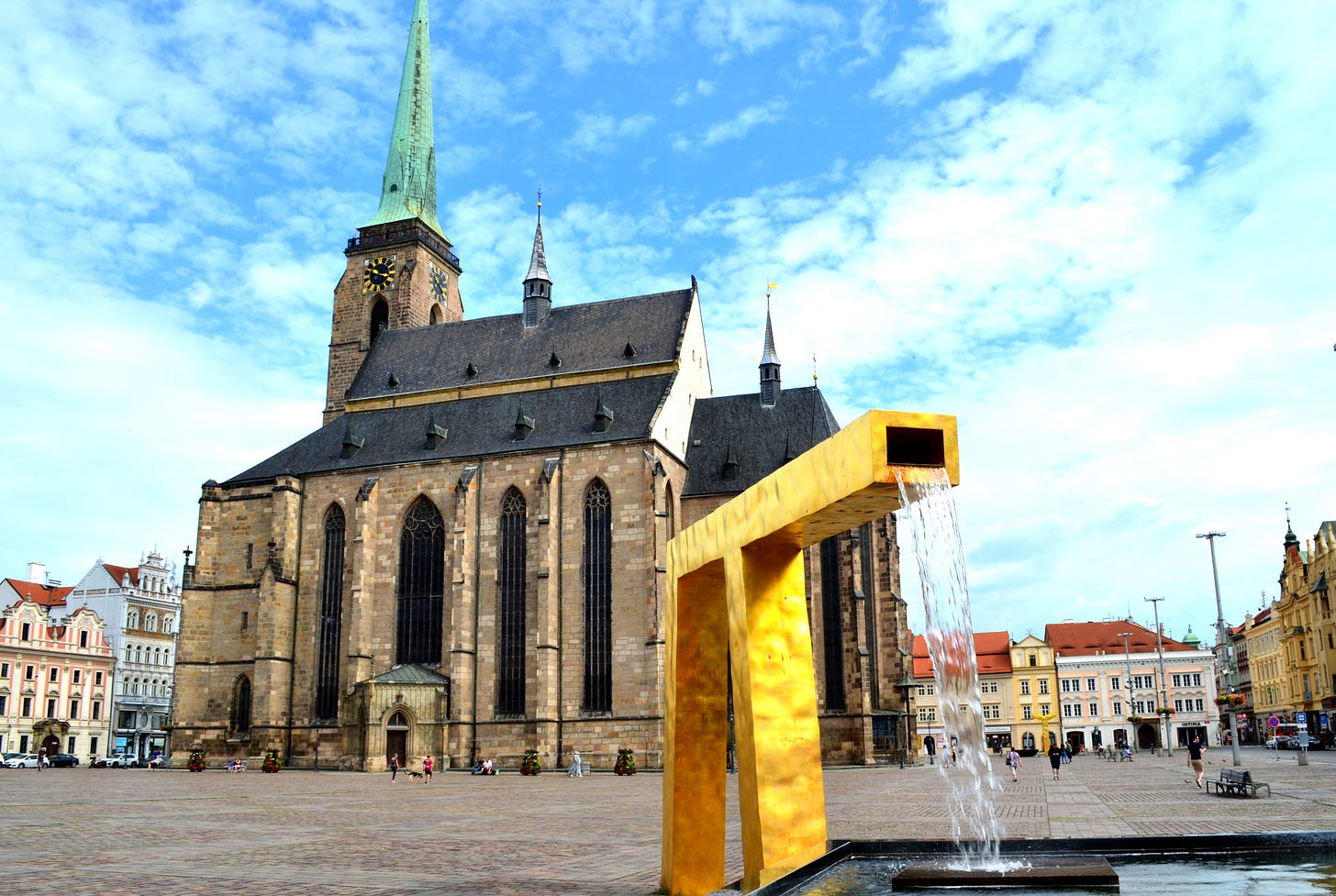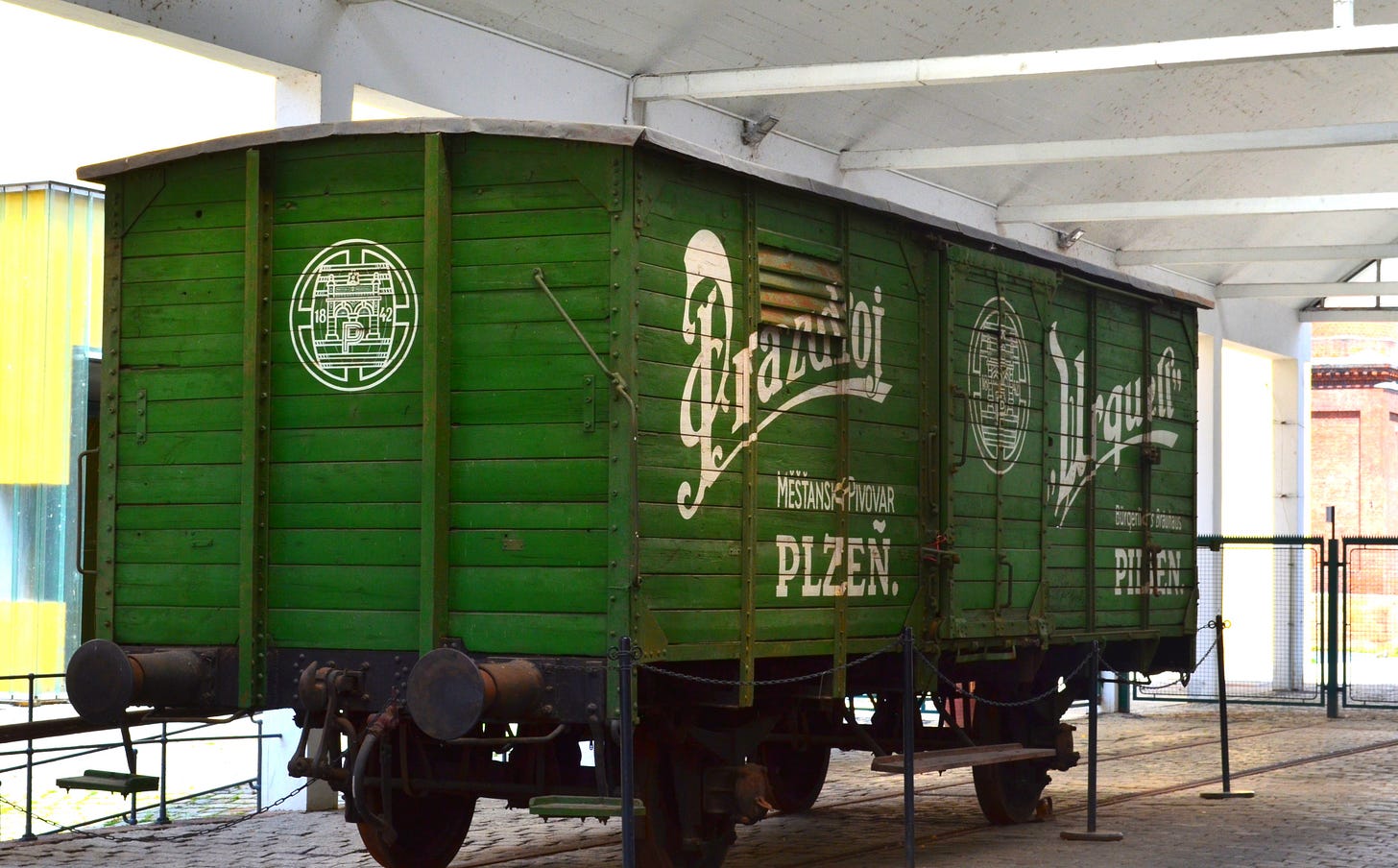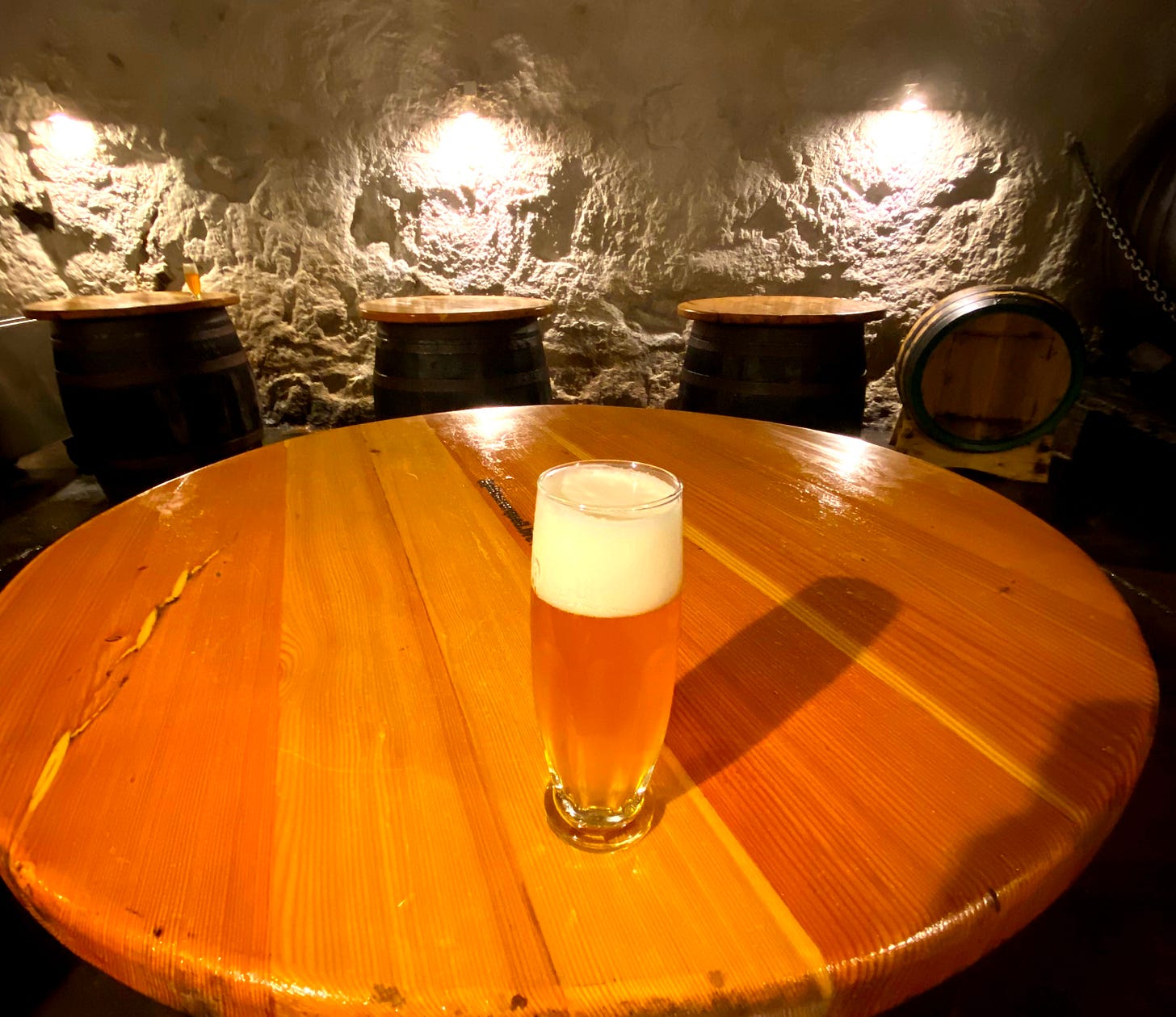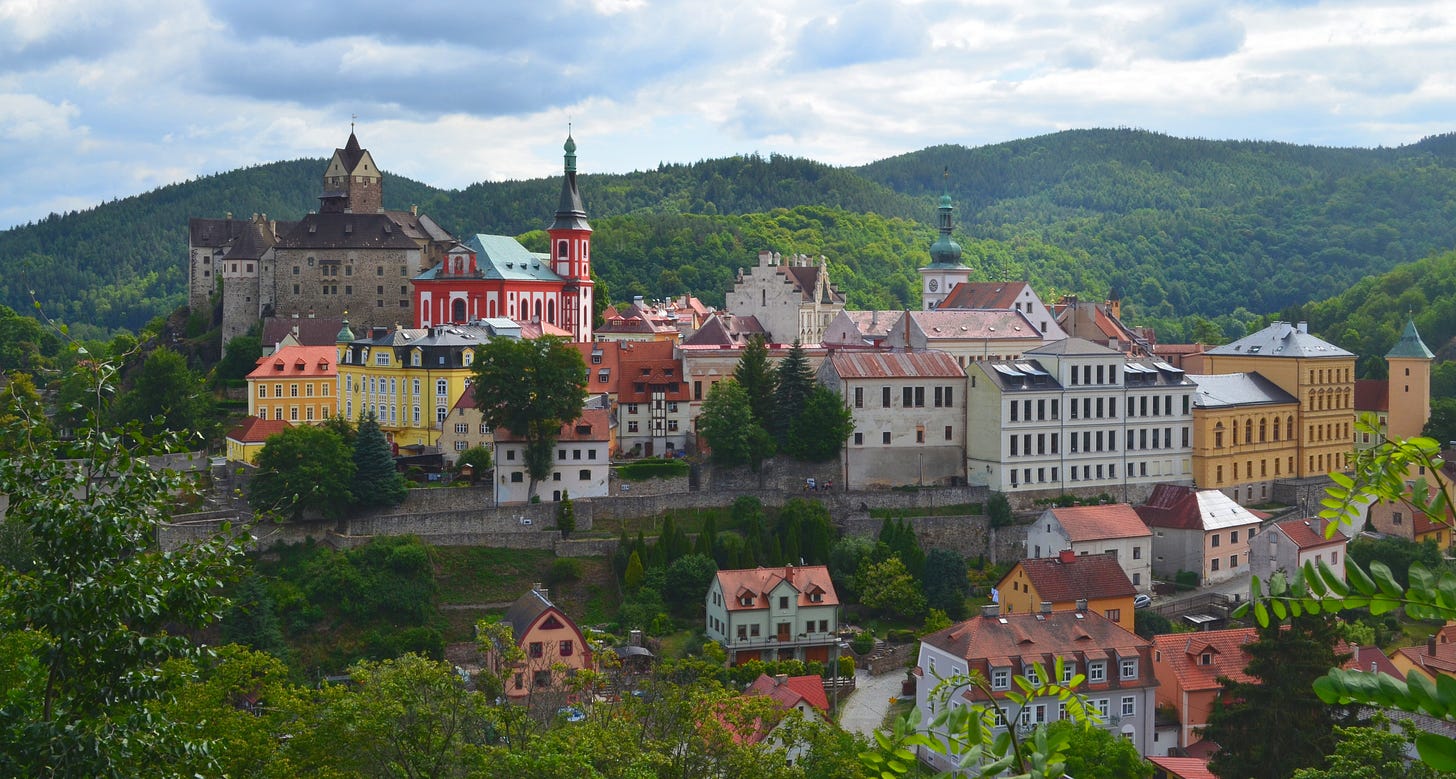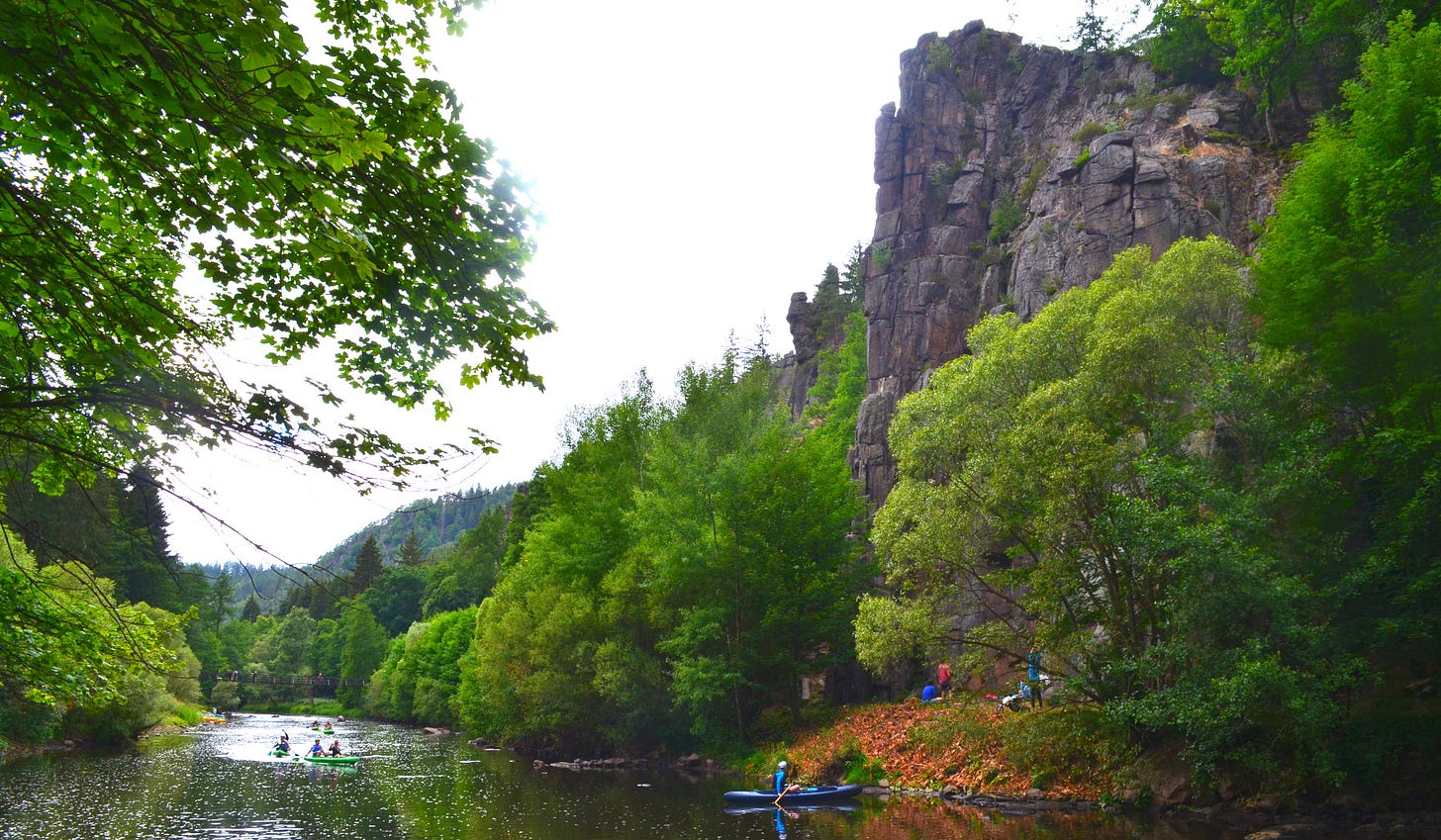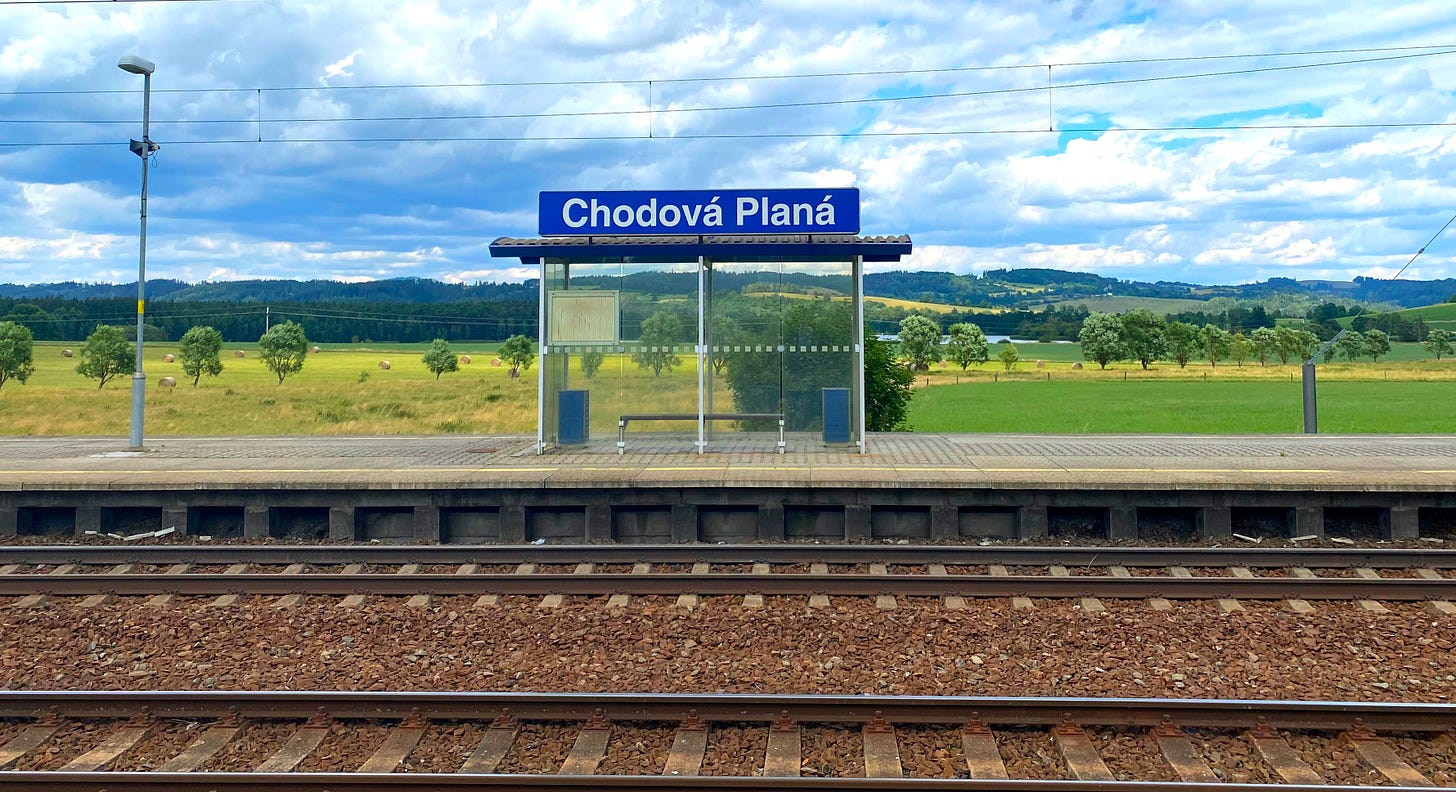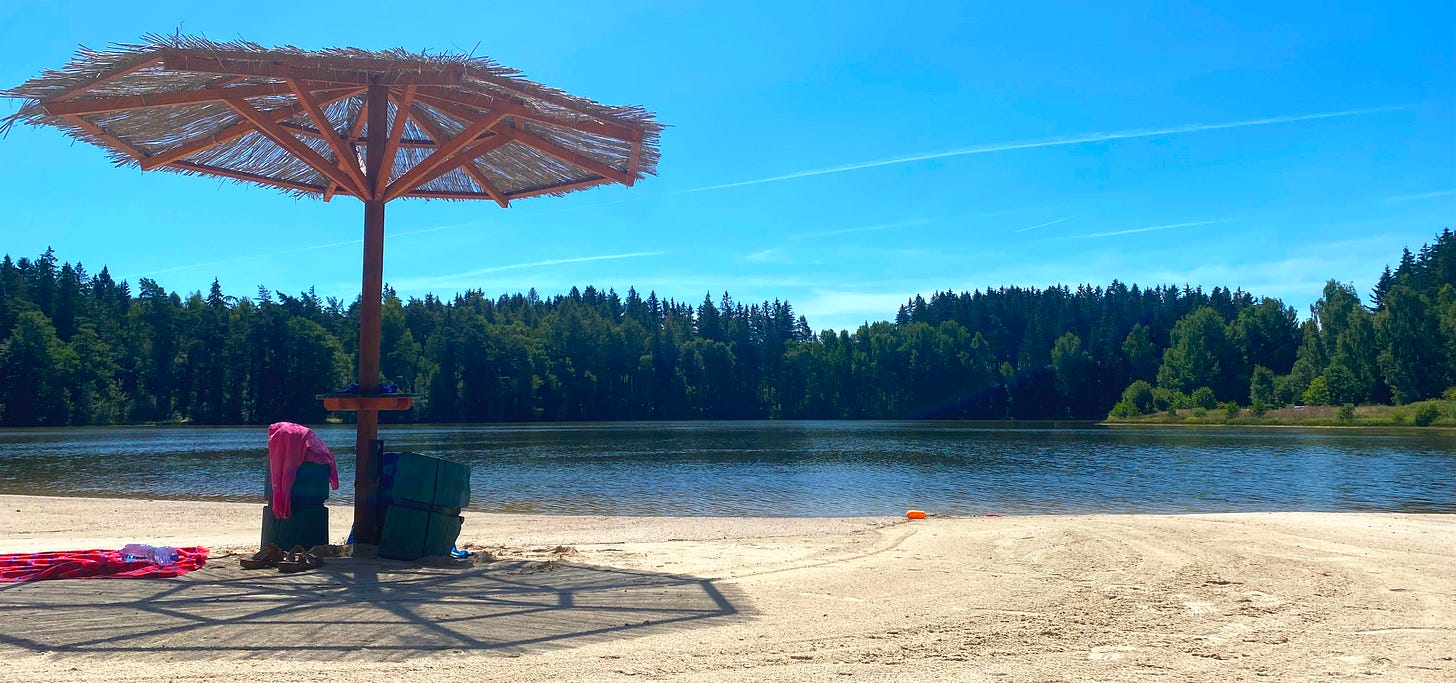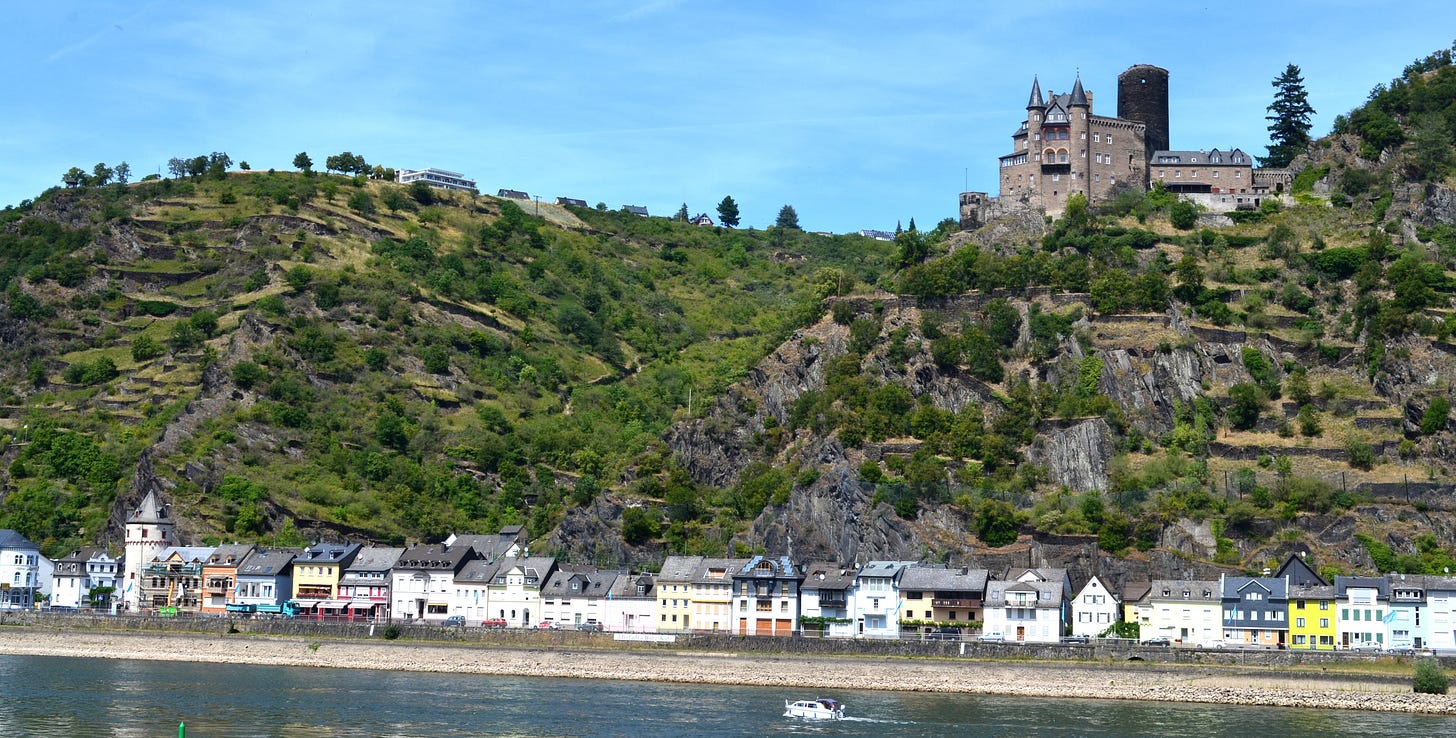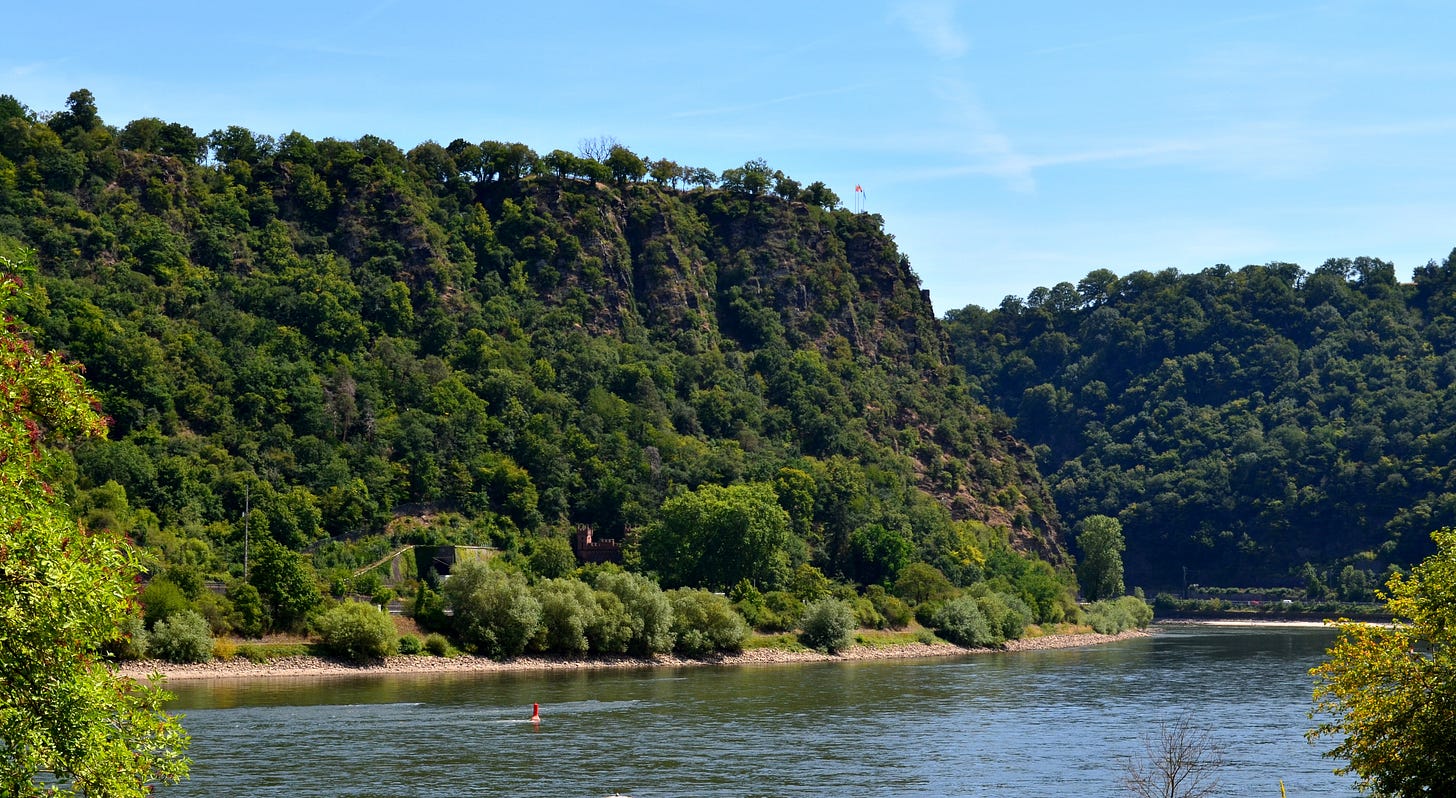Mariánské Lázně Road Trip 2022
Venturing back out of the UK after Covid by exploring the great spa towns of Czechia
"Long journeys wear me out,
But I know I can't live without it"
Thirty-two hours it took. Okay, so an inordinate amount of time was spent at Harwich ferry port, mostly my own fault.
The plan was sound, and I still stick by it. Except for six minutes in Wales due to a diversion on the M5 in August 2020, I hadn't left England (let alone the UK) since October 2019. Not sure if you've heard of Covid-19, but it affected a fair few people. I'm by no means the worst afflicted. I'm still here and still able to travel.
Now travel is possible once again, although reportedly hindered by Brexit, I decided the time was right to do something. But it had to be restorative, (mostly) relaxing, fun, and of course a little bit stupid.
If Fraggle Rock's Junior Gorg-grown-fascist, Viktor Orbán, hadn't been re-elected I was planning a train journey around Hungary. For Hungary, I've long considered, is my favourite country. With that out of the question, as well as a pandemic bookending trip to Ukraine, I was left to reconsider my options.
I should point out that I first went to Ukraine on the way to Mongolia in 2013. A few months later, Russia invaded. I spent a fantastic few weeks in 2019 exploring the gorgeous cities of Kyiv, Lviv and Odesa, as well as the apocalyptic Pripyat and Chernobyl - all of which have been in the news of late because, a few months after I visited, Russia invaded again. I'm sorry, Ukraine. I love your country and people, but I will keep well away.
Going back to reconsidering my favourite country, I thought back to 2018 when I spent an emotionally restorative and frankly life-changing time hiking in the Czech Republic.
I love hiking, I love beer, I love gorgeous architecture. In fact, I had never had a bad time in my many visits (a train delay in Břeclav and a juddery through-journey on the Mongol Rally the closest to being exceptions).
There were some places I'd always wanted to visit but had never been able to crowbar them into an itinerary. They were home to spas. Yeah, I also love spas. Fight me. But only when I'm incredibly relaxed after a spa.
The spa towns of western Bohemia were also drivable from the UK. Technically.
On the road again
Being limited to England in recent years, I had comforted myself with the idea that I was reacquainting myself with my homeland. And I was and did. I really enjoyed Wiltshire, Kent and London.
There was one small area that I hadn't managed to revisit, despite it being one of my most loved parts of England. As a kid, I was lucky enough to have relatives who lived where Cambridgeshire, Hertfordshire and Essex touch borders. Yes, Essex. I loved those times spent in the quadrangle between Royston and Bishop's Stortford.
Having a look at the price of ferries to the Netherlands from Harwich and comparing them to the currently controversial ones from Hull (30mins from my home), I was shocked to see that the Hull ones were three-times the price. The Harwich ferry was also comparable to the Eurotunnel. It had a few more pros in its column: I didn't have to go round London/near Dover and its potential queues. I could sleep on the ferry. I could even have a drink. Yeah, that sold it.
It was decided. I would leave home at 9:00am for a ferry that, at best, allowed embarkation at 7:00pm, before setting sail at 11:00pm. I would visit Royston, Barley, Audley End, Saffron Walden and the further-out village of Finchingfield.
It was amazing to walk round these places that I can't have visited in more than 25 years (except Audley End for my cousin's wedding). They were as perfect and as charming as I remembered. I also went to Halstead: a hard place to cross the road.
I arrived at Harwich a mere seven hours before the ferry would set sail. On the ferry, though, I did have an Orient Express-style cabin to myself. Well done, Stena.
A long way to go and a short time to get there
I had told my lodging owners that I would be in Mariánské Lázně by 6:00pm, giving me nine hours to get from Hoek van Holland.
Disembarkation was mercifully quick. I was even allowed into the EU passport queue and the Dutch border guard remarked upon my Ukrainian passport stamps. It was then I realised I was dressed in the colours of the Ukrainian flag, also wearing the T-shirt of a band from the Ukrainian diaspora. How to make friends and influence passport control.
Germany's massive. I knew this. With petrol prices quite high (although markedly cheaper on the continent), I couldn't replicate Jim's haste on the way to Budapest in 2010 when he burned through a tank of fuel in, what would be, my only hour's sleep on that 27-hour drive.
It was hot. It was a slog. But I loved it. Especially my pre-planned soundtracks (boast!) which enabled me to scream the words to Half Man Half Biscuit's Vatican Broadside, open-windowed, as I passed the polizei near to Dortmund. I like to think they agreed. Nine-and-a-half hours is a long time. Admittedly, not so long that Hugh Grant would star in a film about it. I was deep in the cherrylands near Eisenach by the time I had reached halfway. That sentence wouldn't have meant anything to me before this trip, so don't worry.
But I made it. And I loved my balconied apartment in the cool part of Mariánské Lázně. After a very necessary shower, I explored this glamorous spa town. A bit. I then walked through a park, was asked to take a photo by a mother and her less-keen son, and went to a pub-restaurant that I could see from my balcony.
With travel dissipating from my memory and any of my German, and recently learned Czech, as clear from my mind as any Phil Collins video except the one he did with Bone Thugs N Harmony (seriously, check it out... Home. It's like kindly gangsters caring for a baffled old man), I spluttered a few indecipherable words of my own version of Esperanto. The friendly barmaid recognised I was trying to speak in German, but then asked if English would be better. She was right. I ate, drank a beer and went back to the apartment.
At this point, I had travelled for 32 hours for a schnitzel.
Another night, another schnitzel
In my hunt for bashed-and-fried pork, I hadn't really had chance to survey my new hometown - a must any time I move, no matter for how long.
There was a time when I was at university in Leicester. In what turned out to be my final month, my friends and I moved into part of a sweatshop. Honestly, we could see into the factory from our shower and, even though none of us wished to contemplate it, vice versa. The factory turned out the latest fashion by "Tommy Hifliger" amongst others. That's not a typo.
On moving in, myself and a good friend and equal pub-enthusiast decided to scope the lay of the local lands. We were about 400m from where we had spent the previous years, but this stuff matters. One of our visits was to a flat-roofed 1960s pub called the Merry Monarch. The window was boarded up and we got the full An American Werewolf in London greeting. We never went back.
The point is, you need to quickly fathom where to go, what to do and, crucially, where to avoid. All I currently knew about Mariánské Lázně was there was a good schnitzellery that I could see from my balcony.
Surely there was more? With mobile data not working so well round here, I opted for the InfoCentrum. I couldn't even find that! (Reader: It was in the Post Office that I would repeatedly pass that day).
After a walk round its impressive central park and colonnade, I returned to my flat's sweet, sweet, comforting, Wi-Fi. A map, in German, hinted at a route near to me that would take me to some of the many, many, many springs that envelop and invade the town. That's why it's one of the "Great Spa Towns of Europe". Not my words, Lynn, the words of no less than Unesco. The placards of other "Great Spa Towns of Europe" are draped, Mussolini-esque, from lampposts. Bath is the only Brit to feature. Why no Buxton, Harrogate, or Boston?
I set off past Kaufland, Tesco and Lidl (in your face, Palin, Theroux, Byron etc) and saw a sign pointing into the woodland. The great thing about the Czech Republic is the attention they give the hikers. Honestly, with all the painted waymarkers and signs, it's a wonder anyone gets lost.
I got lost.
Needless to say, it wasn't for long, and I didn't mind. The pine forests and sense of freedom were my restorative medicine. Before I had to eat humble hiking pie, a sign prompted me to the first spring (pramen). "Bear spring"! So that's what they do in the woods... A mother and her child occupied this one so I strolled on to Balbínův pramen. These springs offer 'cures' and, despite the redness it bestowed on the nearby ground, I picked up a cup (many of the springs have free-for-all-to-use cups on them) and sampled it. It was fizzy!
It also seemed to work as a cure as I bounded away down the track for a long time without feeling tired or even thirsty, despite the heat.
It was joyous to be back in the Czech forests. This is why the nemophile in me had come here.
Another thing they do so well is link up short trails. That way, those that want to can spend half an hour or an hour going round beautiful places, and those who prefer longer walks can spend hours on a route.
Despite my body's suggestions, I still think I'm in the latter crew.
One of the things that I was starting to think was solely a facet of České Švýcarsko was the lookouts, or vyhlídka. There was one here on the Metternichova Cesta (the first trail) that looked out onto trees about five metres in front of it. Not a great view.
After a short, unplanned, detour I was on the Goethova Cesta, which seemed to be a stroll through a geological park. The three cesta allow you to almost circumambulate the town. For the only time here, the signs were in Czech, German and English instead of the inordinately prevalent Czech, German and Russian. It was strange yet informative to see all these rock structures writ large. I felt like Carl McCoy, in that I was in the fields of the nepheline. C'mon, you make a better geology/goth-rock joke!
Being serious though, it soon brought about one of the highlights of the trip: Mecseryho vyhlídka. On my previous walking trip to the Czech Republic, I had conquered a crippling fear of heights/falling to take in some vyhlídky (lookouts). From that experience, I knew how worthwhile they could be. Mecsery lookout was incredible. A picturesque wooden structure framed an immaculate view of the town below. I stayed a while, marvelling at my new, temporary home.
I was in love and high on altitude. I was happily apanthropic. Once again, the Czech Republic had ramped up my serotonin. I was back. I was alive. The serotonin that was formerly fear was running rapidly through my veins. I couldn't get enough of it.
I went for my second schnitzel in two days.
P**s Up in a Brewery
Back in 2010, myself and a friend (Jim) drove to the Sziget festival in Budapest. On the way back, our plan was to go to Plzeň and the Pilsner Urquell brewery. We achieved one of those aims.
There are a lot of pictures of Jim wearing fetching hats in Telč, that's all I'm saying.
Anyway, I was so close to Plzeň that I couldn't let this chance pass again. Many will suggest that the proximity to the home of beer is the reason I chose Mariánské Lázně as a destination and they would be, I guess, mostly wrong.
Of course, once I chose the location, and remembered its closeness to Plzeň, I had to right that wrong. There was no chance I was going to avoid Plzeň.
With a tour of the brewery booked for 12:30pm, I made sure I was there in good time. Like Harwich, I was at least three hours early. This gave me the opportunity to regain my bearings, passing Hotel Slovan and walking into the centre. I took many photos of St Bartholomew's Cathedral and its surrounding golden structures representing the brewing process.
I even went to the Doosan Arena, home of Viktoria Plzeň, one of the finest Czech football teams, and one whose dugout was the same shape of a beer can. I managed to right another wrong. Jim's photo of me outside here in 2010 is an abomination, even by the standards of the age.
This is where Plzeň turned odd. I saw a, presumably, homeless woman put her trousers on. She was commando. The poor child in front of me must be scarred for life. I went to a pub.
Being so close to the Pilsner Urquell brewery, a lot of the pubs have their beer in tanks, fresh from the source. I walked onto the terrace of one. The waiter and waitress asked me what I wanted, so I pointed at the chalk menu that mentioned 'pivo u tanku' and said 'tanku' to signify I wanted tank beer.
In a time that I could have gone to the brewery, poured a beer and brought it back, I still had nothing. Eventually, I asked for pivo. That showed my mistake. Immediately, it was ordered and brought out. I can only assume that every time I asked for 'tanku', the waiting staff thought I was thanking them. For what, I don't know.
But the time had come.
Anna, our genial guide, briefed us on the history of brewing in Plzeň and how 250 brewers and burghers got together to improve the city's beer. In October 1842, the first bottom-fermented pale lager was produced under the guidance of Bavarian brewmaster Josef Groll. It revolutionised beer and more than 70% of beer now sold globally is based on the practices first introduced in Plzeň in 1842. It's kind of a big deal in the beer world and Urquell means 'original source' in German. Pilsners, pils etc, they all hark back to Groll and co's beer, which is still produced using the same methods as they did in 1842.
The ingredients are simple. Dried Czech barley makes the malts (they still don't buy it in), water comes from their own soft water wells (100m deep - the same depth as the town's cathedral is long), yeast activates the sugar in the malt to make alcohol and saaz hops are added. We got to try some ground-up saaz hops. They tasted of the beer, but punchier and stronger, and obviously much, much drier. I can't see them becoming a popular beer snack any time soon.
The tour took in the original brewhouse and the new, glass one. They are stark in their differences. Originally, the brewery produced 100 litres per batch. Now they can make 60,000 litres per batch - and there are 24 batches made per day. That's about 500,000 litres, 880,000 pints, of Pilsner Urquell per day. Mouth-watering. The facilities of the brewhouses are not too dissimilar, the copper kettles used for the triple-mashing and triple-hopping are still in use but now they are much bigger, and there is now a filtering unit.
Other interesting features of the tour are the beer train, which transported the beer from right above the cellars and was in use from around 1900 to 1960; the great glass elevator (the biggest in the Czech Republic), which conveys up to 72 people to the new brewhouse; and the original kettle which was an open-topped one.
Of course, the highlight of any brewery tour is the drinking. No one goes on a brewery tour (by themselves) without looking forward to trying the product. Somewhere in the 9km of cellar tunnels that were all dug by hand are a few remaining barrels. At one of them, a wonderful chap was filling our glasses with unfiltered, unpasteurised Pilsner Urquell. While you can get PU from your local offy, this is the only place in the whole world where you can get this variant. And, you know what? It tasted great. Perhaps it was the salt-licked cellar walls as a venue, perhaps it was the thrill of trying something so rare, but I'd be delighted to have this instead of any other PU (as good as the regular one can be).
After comparing the unfiltered, unpasteurised version with a regular PU from Na Spilce on the premises (purely for research reasons), I left this sprawling complex and... went for a beer or two.
It might seem mad to open craft breweries under the shadow of such a global icon, but the good people of Plzeň have done just that. Whilst there are countless types of craft beer, some with crazy flavours, a lot of them here shared one important detail with their gigantic neighbour: they were silky smooth. There really must be something in the water round here. Whatever it is, it tastes good.
Walk, drink, walk, drink
Of course, the waters round these parts are not just made for beer. As springs and spas, they provide curative treatments for many. While Mariánské Lázně was my home, there was another 'great spa of Europe' that I had wanted to visit for some time. Conveniently, it was walkable from another bucket-list town.
Inconveniently, I couldn't make the train to Loket work. I would have to spend an hour in Nove Sedlo, which was a 50-minute walk from Loket (Elbogen in German).
Wait? What? A plan was forming. In fact, two plans were forming. The days were splitting themselves into walking days or beer days. Yesterday was a beer day. The next day would be a beer day. Today should be a walking day.
I left the train at Nove Sedlo and almost immediately encountered a Soviet flag flying from an allotment, and a rusting Trabant. The latter was much more welcome, but both served as a reminder that geopolitical borders in this part of the world have been fairly fluid for the past century.
Loket is stunning. I knew it was from the pictures I had seen, but reality did not disappoint. A historic hilltop town clinging above a meander in the Ohře river (Eger in German), it had all the hallmarks of a fairytale town, or somewhere in the Dordogne. That wasn't the only time I had that thought that day.
As was becoming tradition, I sought out a suitable vyhlídka, but there are so many opportunities to take in this gorgeous town and its staunch castle. The town itself is small but beautiful: cobbled streets overlooked by stately buildings that I could imagine all formerly housed notaries, magistrates, guild masters, chandlers and the like. There was also a majestic plague column that, while grim of history, is usually a signifier of a beautiful Czech town.
But I had somewhere else to be.
The riverside track was busier with cars than I expected for a dead-end trail. It even had a vending machine for energy bars and drinks... and CBD. However, the busyness was soon explained as there was a campsite and multiple river-sport activity centres. I spent most of the first part of the walk racing canoeists. It wasn't a race, but there were three canoes that I kept seeing in this Dordogne-reminiscent setting.
One thing the French department and river don't have, as far as I remember, are springs. I filled up my now-empty bottle of Orangina (no wonder I was recalling France so much...) with water from one of these and it lasted a fair chunk of the way. Until its sulphuric taste merged with the Orangina residue with unpleasant results.
That had taken me past my first point of note, Svatošské skály, a group of granite rock formations overlooking the river. I'm a big fan of these structures, but what I'm not a fan of is rickety bridges that swing about and bounce when you cross them. I felt like Indiana Jones, but not in that way. "Rickety bridges, why did it have to be rickety bridges?"
The path soon left the riverbank and traversed a hill into an uneventful town, before I was plunged into somewhere quite unexpected: a Czech version of Center Parcs. Seeing kids zip-lining over my head caused a bit of confusion, as did the installation of animal silhouettes in the woodland. It's a good job I had noticed these on a nearby map, otherwise spotting a wolf peering out from behind a tree could have caused quite the shock.
A couple of ornate chatas (shelters) and an incongruous face-in-the-hole, Aunt Sally board provided additional strange sights on the walk before I came to rozhledna Diana. This lookout tower on the edge of Karlovy Vary is popular and... unnecessary. More than 100 steps take you to the top of the tower (I opted for the lift, for once) and you find yourself too high above the famed spa town. The hill is already tall enough to have benefitted from a vyhlídka and I witnessed much better views of the town on the walk down. I've said it before and I'll say it again, sometimes viewing towers are completely unnecessary as you struggle to make out much below. It was free though.
As mentioned, some of the views on the tough walk down were beautiful, and I really enjoyed entering the town via a small alleyway beside the Grandhotel Pupp. The channelled Teplá river with its fountains is lined by grand, ornate buildings and this is where I decided to change my walking socks into more appropriate ones (I had already changed my top in the nearby woods). The sight of someone taking their socks off near designer shops that I'd never heard of may have surprised some.
That wasn't the only reason I felt out of place. Karlovy Vary really is grand, opulent, luxurious, high-end. Call it what you will. It's posh, and so are its visitors. Along the riverside, the prices reflected this but I soon found a return to normal prices in the town centre. Thankfully, I didn't feel as out of place as the Hotel Thermal looked. This functionalist giant steals focus at the town centre end of the riverside walk. It took 10 years to complete before it opened in 1977 and some might say it's a concrete carbuncle. Me though? I'm quite attracted to these opinion-splitting structures that often dominate parts of former Eastern Bloc countries.
Karlovy Vary is also the birthplace of one of the Czech Republic's most recognisable drinks, Becherovka. This herbal bitter was introduced by Jan Becher in 1807 and massive versions of the bottles dot the streets. There's even a museum, which is also home to a brewery/restaurant.
I left Karlovy Vary on a glorified tram that took the back route to Mariánské Lázně, through gorgeous forests and past the impressive 14th-century state castle at Bečov, which is home to the reliquary of St Maurus.
Hoppy bathday to me
I filled up another empty bottle at the Antoníčkův pramen in Úšovice, a southeastern suburb of Mariánské Lázně, before once again returning to the countryside. This was different, though. As I passed through Stanoviště, it was clear that I would be in predominantly open countryside today. Then the scenery changed four times in a mile.
Farmland, shale rocks, pine/beech forests, loam. It was quite incredible how rapidly it changed. And quite incredible how rapidly I walked through Chotěnov - home, seemingly, only to a couple of angry dogs.
I had passed the third of four hamlets in good time and realised I hadn't seen another person or another car. Then a car whizzed past me. There's a lot of time for thinking on solo walks, and I remember remarking to myself that the Czech way-marked footpaths are so well organised. The iconic tricolour markers are regularly dotted on trees or posts to guide you safely and easily to your destination. Recalling past walks, I noted that every time I thought I'd not seen a marker for a while, one turned up almost immediately.
At this point, I was walking up a huge, long hill and had emerged in farmland. According to the map, I should have turned off into more woodland. I retraced my steps and located the previous marker halfway down the hill. I could only deduce that a local farmer had fenced off the route. Czech way-marked footpaths are so well organised... until they're not.
I really should stop thinking.
My early assertion that there were so few cars was now looking ridiculous, too. Plunged into Plan B, I was now beside a busy road, regularly jumping on to the verge to avoid the traffic. Thankfully, it wasn't far from where I needed to be: Chodová Planá.
This small town is largely taken over by the local family brewery (rodinný pivovar), Chodovar. This was where I was about to do something I'd heard was popular in these parts but sounded quite weird to me.
Ah well, in for a penny and all that.
So, I stepped into a bath of beer and sat there for about 20 minutes, bathing away whilst drinking a glass of fresh beer from the adjacent brewery. Beer spas are quite popular and you can find them in many Czech and Bavarian towns. Apparently, there are multiple benefits from bathing in beer: relaxation, detoxing, smooth skin, shiny hair. I was sceptical but I definitely felt better and more relaxed after having it. My hike-heavy feet were rejuvenated and my skin did feel smoother. Mmm, beer. Is there anything it can't do?
No! It turns out it can even turn quite a peaceful, upmarket spa town into a thriving festival site.
Upon my return to Mariánské Lázně, I noticed there was a craft beer festival taking place next to the Colonnade. Good beer, food and music was available and, unsurprisingly, I thoroughly enjoyed spending some time there. As did others. The sight of a grandmother dancing enthusiastically with her granddaughter to various Calvin Harris tracks was a thing of beauty. Yes, I had to Shazam the music to find out what it was.
I love to live so pleasantly...
The morning sun was already beating down and, on my final day in town, I thought it was time to apricate.
A day on the beach is a bit harder to achieve in central Europe as opposed to the East Riding, but with the nearest coast 400 miles away, I opted for the relatively close lido. Walking 40 minutes each way in flip flops seemed like a good idea for about 10 minutes.
In the middle of a dark pine forest was what appeared to be a small holiday camp. I couldn't help but feel I had walked into the Czech version of Carry on Camping. There was a small entry fee, the equivalent of a couple of 'paaahnd', as Peter Butterworth's Mr Fiddler would have it.
Inside, there was a refreshment shack and a pristine golden beach dotted by fronded parasols. I could have been on a tropical beach, if it wasn't for the view. The serene, obsidian lake backed by ominous pine forest recalled more a location near Winden from Netflix's German drama Dark.
The sun was piercing as I spent a while under the parasol reading and tanning, before I went for a dip, with kayaks and pedalos in the near distance.
Mountains, rivers and forests for hiking; great beer and food; wonderful architecture; spas and natural springs; and now a beach. This part of the Czech Republic really does have everything.
Seeking a bit of shelter back at the flat - my island on the fourth floor - it had cooled a fair bit before I went out for a final wander round Mariánské Lázně. And it was a good job I did go for a stroll.
I had forgotten that, by the main Colonnade, was the Singing Fountain. There are 250 orchestrated and illuminated water jets putting on a fine display to music. If I had been there a few hours earlier, I would have heard Karel Gott's Být stále mlád, a Czech language version of Alphaville's Forever Young, that seems to be the unofficial anthem of Mariánské Lázně.
However, as it was, I was serenaded by Andrea Bocelli's Time to Say Goodbye. It seemed incredibly fitting.
Coming home
With the UK and Europe beginning to bake in record-breaking temperatures, now seemed the ideal time to commence a two-day car journey back home.
I stopped to fill some water bottles up at a natural spring. That turned out to be an error as, just hours later, they had turned an unappetising brown colour. I suspected they may still be drinkable but, with the aforementioned two days in a car, it didn't seem worth the risk.
The first few hours were uneventful, apart from a sense of regret creeping over me as I passed the German home of beer, Bamberg, and didn't stop. It was 10am, mind... Oh, and I was driving.
Approaching Würzburg, I noticed my phone satnav had stopped working and that I was running out of petrol. I was listening to AC/DC's Highway to Hell and had just passed the 666km marker of that particular autobahn. Ominous.
After filling up near Frankfurt and fixing my phone, I laughed at the sense of dread I had felt at those combined omens. Then there was an incident with a rock.
Fixed and back on the road, there was one more bucket list destination to visit.
I had always anticipated that I'd first see this location from the window of a southbound train, but as I drove northwards up the Rhine Valley from Bingen, I didn't mind. I was glad to see it in all its splendour.
Stepped vineyards climbed high above the river and I could believe they had been there centuries. But it was the castles and other spectacles that really grabbed the eye. I stopped in Sankt Goar to have a stretch of the legs and look at Lorelei. This large slate rock has gone down in German folklore. In Heinrich Heine's 1824 poem, Die Lorelei, the eponymous female is described as a siren who sits on the cliffs high above the Rhine, combing her golden hair, and causing sailors to crash on the rocks due to her beauty and siren song.
Leaving Boppard by the hilly route wasn't much fun as a single carriageway wound its way up the steep incline and round hairpin bends. A learner driver was coming down the hill. I don't envy them...
By the time I got to my lodgings in Goch in northwestern Germany, it was sweltering. A chilled pilsner didn't touch the sides as I sat down in the main square for some food.
The heat rose the next day and, as I queued up to get on the ferry at Hoek, the car registered a temperature of 46 degrees in the sun. I had chosen wisely to get a cabin.
The two showers were rendered pointless as I waited in the car deck for 30 minutes to disembark. Even at 11:00pm near Grantham, the temperature was still in the 30s.
But this only added to the feeling of relief to be back out travelling. The tiring drives, exacerbated by crazy temperatures, give me a sense of real adventure. I recalled driving across the Kyzyl Kum desert and the technology-wrecking heat that pervaded.
Mostly, though, I considered how the Czech Republic had firmly asserted itself as my favourite country.
Uvidíme se příště. Čau čau.





